And that’s what this article is going to talk about: some of the various Filipino longganisa types. Whether you’re a food enthusiast or a home cook looking to expand your culinary repertoire, understanding the vast array of longganisa varieties across the Philippines is a journey worth taking.
Get ready to enjoy the many delicious flavors of this popular Filipino breakfast staple!
Longganisa Pinoy Variety 1: Chorizo de Cebu
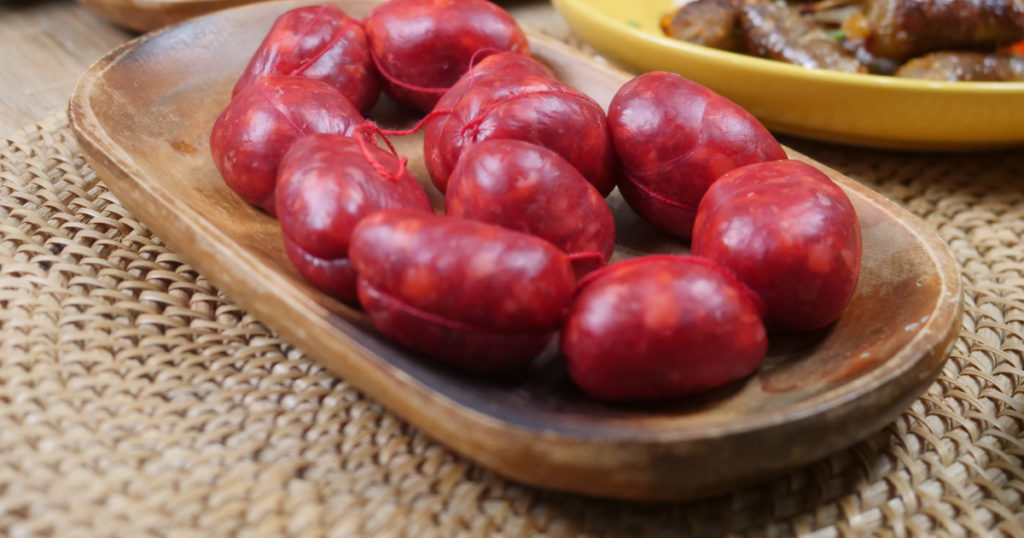
Chorizo de Cebu, also known as longganisa de Cebu, is a beloved pork sausage from the Cebu region. You’ll know it by its sweet, spicy, and garlicky flavor profile. This longganisa hamonado-type stands out with its vibrant red color from achuete seeds and distinctive spherical shape.
Made from a mix of lean pork, pork fat, salt, pepper, sugar, anise liqueur, paprika, garlic, and chilis, it’s encased in hog casings but can also be prepared without them. You typically enjoy this Filipino fried or grilled alongside white or garlic rice, or with puso—a traditional rice wrapped in palm leaves. It’s a versatile and flavorful addition to any Filipino breakfast table.
Longganisa Pinoy Variety 2: Longganisa ng Lucban
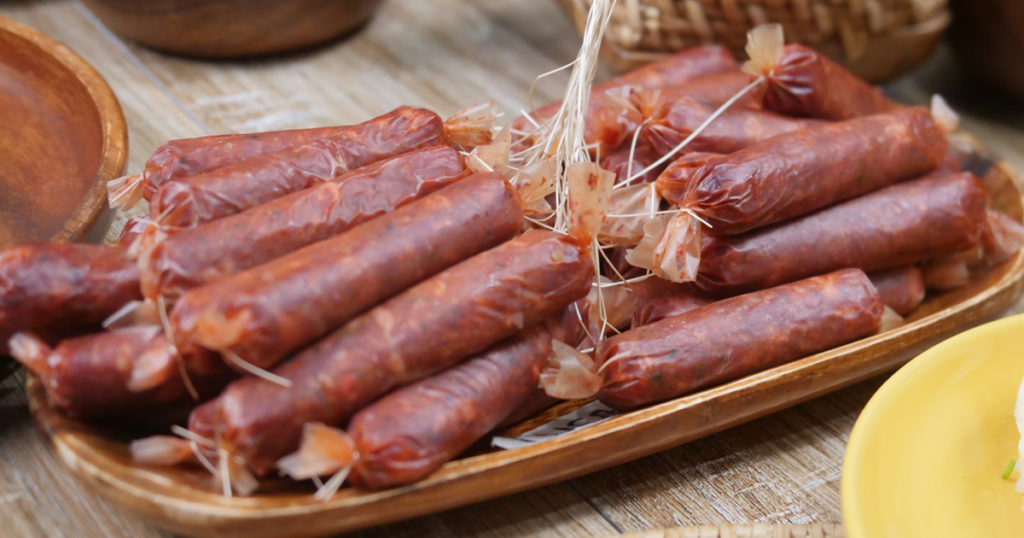
Longganisa ng Lucban is a distinctive Filipino sausage from the town of Lucban in Quezon province, celebrated for its unique garlicky and sour profile. Unlike the more common sweet varieties of longganisa, makers infuse this Filipino longganisa dish with a blend of Mediterranean spices like oregano and smoked paprika, alongside a generous amount of garlic and vinegar.
Aside from the ingredients mentioned above, you usually make this with lean pork, pork fat, coarse salt, sugar, and vinegar, and wrap it in a thick casing, although it can also be enjoyed without the casing. Traditionally served with fried rice and atchara (a Filipino pickled dish), it pairs exceptionally well with Pancit Habhab, another noodle dish that originated from the Quezon province. This sausage’s preparation involves curing the meat mixture in casings, highlighting its robust flavor that’s best savored as a hearty breakfast or a savory snack.
Longganisa Pinoy Variety 3: Vigan Longganisa
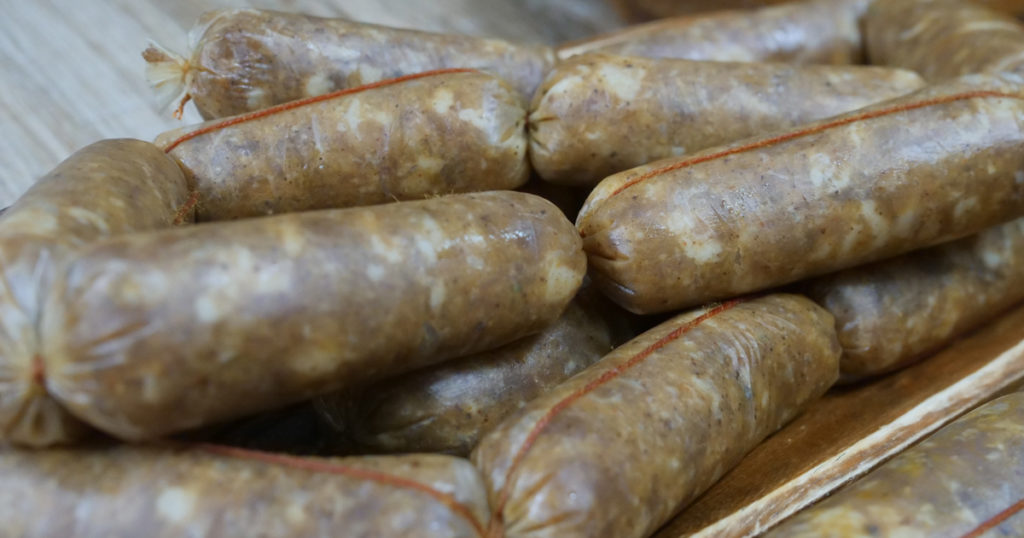
Vigan Longganisa originates from the Ilocos region. When you make them, you hang the sausages under direct sunlight for 4-6 hours to drip dry the fat and excess liquid, then pan-fry them until brown. This method, akin to the traditional smoking over an earthen stove, imbues the Vigan longganisa with a distinct smoky flavor, enhancing its sourness.
Eat it with Ilocos vinegar for an added zing. Have it for breakfast with some garlic rice, tomatoes, and a fried egg for a savory and tangy start to the day!
Longganisa Pinoy Variety 4: Alaminos Longganisa
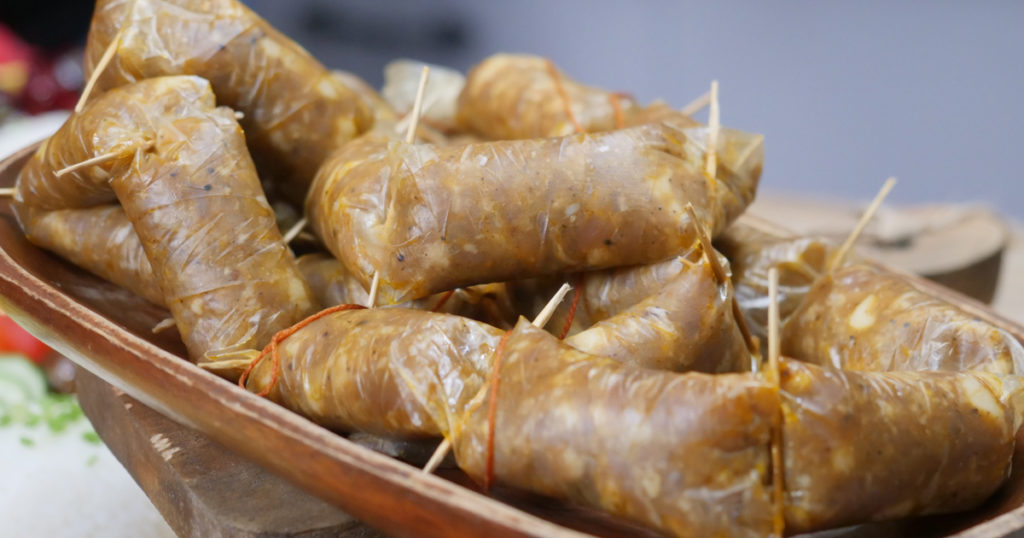
Alaminos Longganisa hails from Pangasinan. It is the perfect little treat for anyone who wants mild flavors and cute, bite-sized portions of food. Aside from it being slightly sweet and having the right touch of garlic, it also has a distinct look.
Instead of the usual twist or string tying these sausages together, makers connect them with little sticks called “buli,” making each string of Alaminos Longganisa look absolutely unique. It’s the kind of detail that adds a dash of fun to your cooking and might even get the kids interested in what’s on their plate.
Oh and a fun fact? Alaminos Longganisa is a star in its own right, celebrated every year at the Longganisa Festival. So, when you bring these Filipino sausages into your kitchen, you’re not just cooking up a meal; you’re whipping up a piece of cultural pride!
Longganisa Pinoy Variety 5: Imus Garlic Longganisa
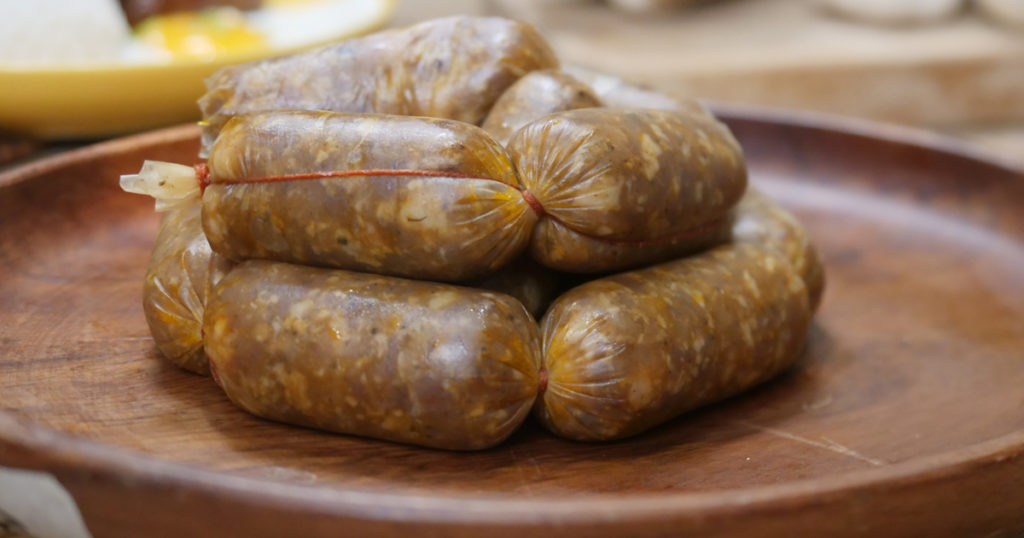
Imus Garlic Longganisa, from Cavite, is one of those Filipino recipes that is a dream come true for garlic enthusiasts. It’s packed with a punch of garlic flavor and has a very bold taste. It’s a recado longganisa, after all. It’s a straightforward recipe that delivers: just combine ground pork, plenty of garlic, soy sauce, vinegar, black pepper, and a touch of achuete seeds for color, and you’re good to go!
You can choose to encase it in hog casing or go for a skinless longganisa variant, depending on your preference.
Longganisa Pinoy Variety 6: Pampanga Hamonado Longganisa
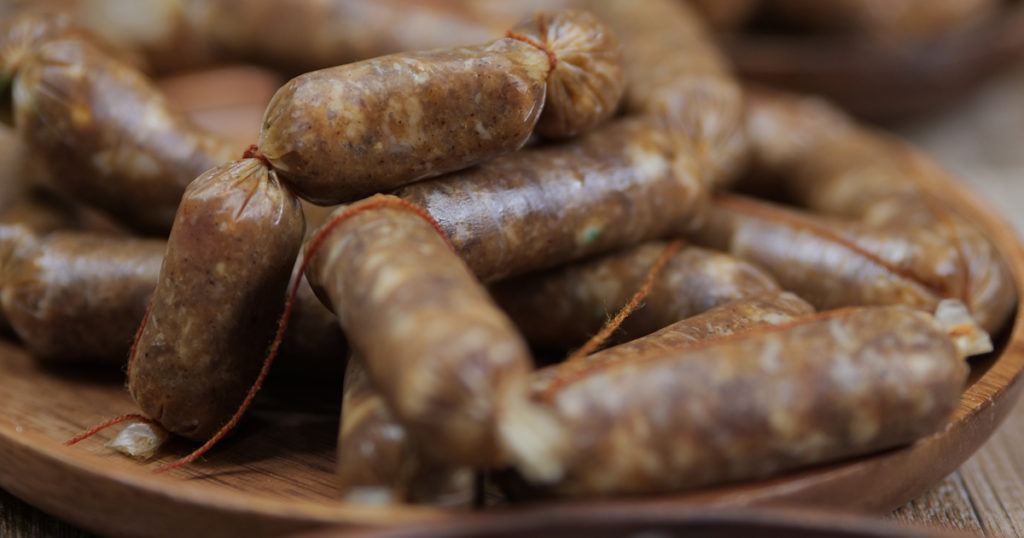
Pampanga Hamonado Longganisa brings a sweet and juicy option to the table. This delightful sausage is known for its rich, hamlike taste that comes from being marinated in pineapple juice. It also has a distinct appearance; while makers often color it orange or red with achuete seeds or annatto powder, the usual longganisa look, this longganisa variant is typically longer and thinner.
Unlike other Philippine sausages that may lean towards the garlicky or spicy, Hamonado is a Filipino sweet sausage, making it a hit for those who prefer this flavor for breakfast. The mixture of ground pork, garlic, brown sugar, black pepper, coarse salt, and a hint of vinegar creates a flavor profile that’s both comforting and satisfying.
Longganisa Pinoy Variety 7: Calumpit Longganisa
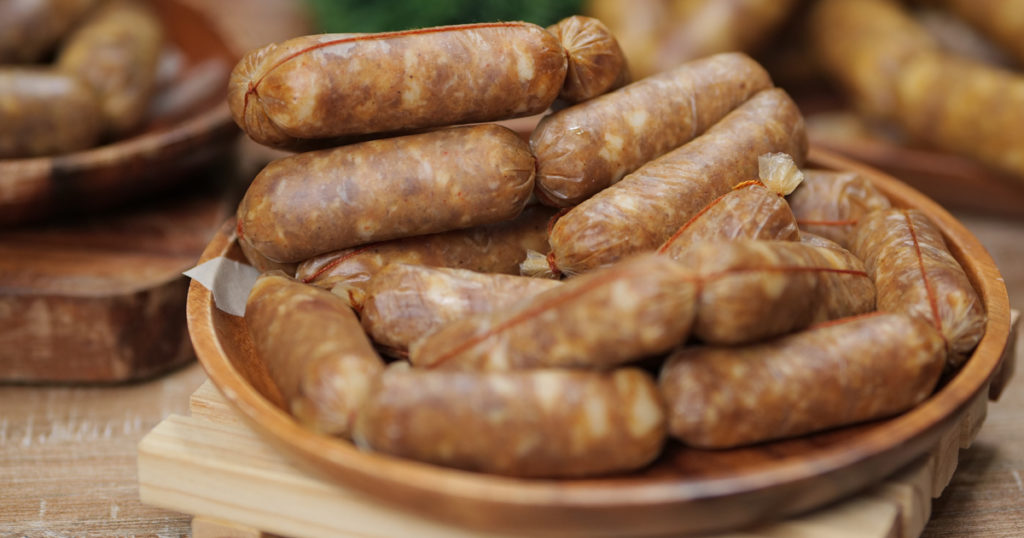
Calumpit Longganisa, hailing from Bulacan, Philippines, is known locally as longganisang bawang. This other recado variety in this list is crafted from a mix of lean ground pork, pork fat, and a generous helping of garlic, along with bay leaves, brown sugar, soy sauce, vinegar, salt, and black pepper. Typically, you boil this Filipino longanisa before frying it to achieve the perfect level of doneness, allowing its flavors to fully develop.
Calumpit Longganisa comes in original garlic, spicy garlic, and sweet and spicy varieties. The flavors cater to different tastes – whether you want something traditional or spicy to start your day. With its garlicky profile and touch of sweetness or heat, Calumpit Longganisa offers delicious options to actively customize your experience.
Want to learn a Pinoy longganisa recipe?
Want to start making your own longganisa after reading all about it? Looking to try the diverse longganisa varieties?
Well, you don’t have to go far. Just enroll in Chef Chona Garcia-Laureta’s latest class here at The Bailiwick Academy: Philippines’ Regional Longganisa!
It’s an easy-to-follow class, perfect even if you’re a beginner at making these. And at the end, not only will you be able to make a delicious longganisa Filipino breakfast, you might find yourself posting Filipino longganisa for sale in your social media accounts.
After all, who wouldn’t be attracted to not having to travel to taste their favorite longganisa variants, right? It makes for a pretty good food business!
So what are you waiting for? Sign up at The Bailiwick Academy and start your journey to being one of—if not the best longganisa supplier—in the Philippines and all over the world, today!
—
Keep coming back to The Bailiwick Academy blog for more baking and cooking tips, kitchen tricks, and much more!
]]>That’s what we’ll find out here! Keep reading especially if you’ve taken an interest in making food with the finest ingredients—even in the comfort of your home kitchen!
Key Takeaways
- Gourmet food distinguishes itself through quality ingredients, culinary expertise, exquisite presentation, attention to detail, and unique flavors.
- Gourmet food is usually prepared and eaten for special occasions, but there’s nothing wrong with indulging in it for your personal enjoyment.
- There are certain characteristics of gourmet food, but it’s more of a concept than strict rules that must be followed.
- Gourmet food is not limited to fancy, expensive restaurants. Even home cooks can make gourmet food at home with attention and dedication to the recipe and to detail.
So… what’s gourmet?
First things first: What is the definition of gourmet? As a term, “gourmet,” according to Wikipedia, is a “cultural idea associated with the culinary arts of fine food and drink, or haute cuisine, which is characterized by refined, even elaborate preparations and presentations of aesthetically balanced meals of several contrasting, often quite rich courses. The ingredients used in the meal tended to be rare for the region.”
What a mouthful, huh? Well, think of it this way: it’s a refined appreciation of food and drink. It’s also often used to refer to high-quality, specialized tastes associated with the culinary arts.
Ever watched “The Menu”? That film gives an example of how a gourmet meal is prepared. It’s very artistic—just make sure to skip all the parts where people, uh, expired, yeah?
You can associate the term gourmet with opulent, extravagant, lavish, sumptuous food—pretty much all the superlatives you can think of! That’s why gourmet food is seen as something very expensive.
Gourmet can also be used to refer to a “foodie”—someone who sees food as an edible luxury. They appreciate the amount of preparation the food takes and enjoy the experience of eating it slowly to savor every bite.
Where did the word “gourmet” come from, anyway?
The word “gourmet” comes from French culture. So you can thank the French for that, as well as for the creation of baguettes and the opera cake.
Going back, according to More Than Gourmet, the original word was “gourmont”, meaning wine-taster or broker employed by wine sellers. The sellers needed the gourmont to have a refined palette to detect high-quality, delicious wines. Over time, it has evolved to not just mean these wine-tasters but also encapsulate the essence of fine food and drink and artistic presentation.
What makes gourmet food… well, gourmet?
Did all those grand words make you confused? Well, let’s get to the heart of the topic and be more specific. What makes something gourmet?
In no particular order, here are some of the defining characteristics of gourmet cooking:
High-Quality Ingredients
Gourmet food uses the best possible ingredients, whether locally or imported. Think of things like special cheeses, rare spices, or truffles. Each item is chosen for its top-notch taste and how it adds to the meal.
Some gourmet restaurants also use rare ingredients or ingredients that need special preparation, such as Morel mushrooms. These add to the exclusivity of the dining experience.
Artistic Presentation
Gourmet food is not just tasty but also looks amazing. The way it’s arranged and presented makes it look like a piece of art, catching your eye even before you take a bite. An example of this would be the way, say, Chef Miko Aspiras arranges and decorates his food creations.
Attention To Detail
Gourmet food preparation means you will pay close attention to every little detail, from how the dish is plated to the exact cooking time. Every step is carefully thought out to make the meal perfect. You’ll need to be very meticulous!
Unique Flavors And Pairings
Gourmet dishes stand out with their unique and surprising flavor combinations. These dishes blend sweet, savory, and unexpected tastes, making eating more than just a meal but a full sensory experience. Think of unusual food combinations that work, and you’ll have an idea of the taste you’ll encounter.
Do all these conditions have to be met for food to be considered gourmet?
To be honest, there are many more ways for a food to be considered gourmet. But think of gourmet more as a concept; it’s subjective.
For example, high-quality ingredients are usually used in gourmet dishes, but it could be that the concept of a chef is simplicity and freshness. That means they can use a freshly harvested vegetable from their backyard garden and then serve it as a simple salad but add an ingredient considered gourmet, such as truffle oil or caviar.
Another way it can be gourmet but not meet all the requirements is if you have a dish that is presented simply but has intricate flavors. Conversely, you can also present very beautifully prepared foods but have straightforward flavors.
In short, while gourmet food should have common characteristics, it’s more about the overall quality, effort, and intention behind the food.
Examples Of Gourmet Food
Gourmet cuisine is diverse, embracing both simplicity and grandeur and represents the best in culinary craftsmanship. Here are different examples of gourmet food—from different cuisines, too!
- Cheeses: Famous cheeses like Parmigiano-Reggiano, Roquefort, Brie de Meaux, and Manchego are loved for their special flavors and textures.
- Meats and Seafood: Think of super tasty meats like Wagyu beef and Iberico ham or seafood like Alaskan king crab. Truffles, too!
- Sushi: Omakase sushi is where the chef picks the best for the day. It’s a great example of the freshness and art of Japanese gourmet dining.
- Appetizers: These are the starters, like Delicate canapés, exotic-topped bruschettas, and caviar-laden blinis. They set the stage for a whole gourmet spread.
- Main Dishes: Think of meals like a juicy steak with a fancy sauce or special seafood dishes that bring about a symphony of flavors.
- Desserts: Sweet stuff at the end, like fancy pastries, special chocolates, or desserts with shiny, edible gold on them. The opera gateaux of Chef Ely Salar is a great example!
- Oils and Vinegars: Examples are the best olive oil from Italy or well-aged balsamic vinegar from Modena.
- Pasta and Rice: Handmade pasta with a yummy sauce or rice dishes topped with gold leaf.
- Breads: Imagine freshly baked bread like sourdough, layered croissants, or soft brioche—yum!
- Street Food with a Twist: Normal snacks made fancy, like lobster sandwiches, truffle fries, or tacos with foie gras.
- Drinks: As mentioned above, gourmet isn’t just about food. Think of wines from iconic vineyards, distinct single-origin coffees, or whiskies aged to perfection.
When is gourmet food appropriate?
The arts of fine food have the power to transform any dining experience into something that will be remembered, well, forever. Here are some suggestions when gourmet food is suitable.
- Special Occasions: Celebrations such as weddings, anniversaries, birthdays, and engagement parties are perfect occasions to have gourmet dishes. They add a touch of sophistication and luxury and make the event feel more special.
- Date Nights: Show your partner love and appreciation with gourmet cuisine. This makes the date even more unforgettable.
- Gift Giving or Souvenirs: Gourmet food baskets, artisanal chocolates, or a bottle of top-quality wine or champagne can make for thoughtful and luxurious gifts. As of this writing, it’s Ber months already in the Philippines—there’s time to think about it!
- Personal Milestones: Celebrating your wins, like a job promotion or completing a challenging project, with a gourmet meal can be a delightful way to reward yourself.
- Cultural and Food Festivals: Gourmet food stalls and pop-ups at festivals give attendees a chance to sample a wide range of delicacies from different cuisines. Check out upcoming food festivals. These can become food business opportunities.
Of course, enjoying gourmet cooked meals doesn’t always need a reason. “Just because” is a perfectly good reason!
Can home chefs make gourmet food?
Now, here’s the question: Do you need to be a gourmet chef to prepare a legitimate gourmet dish?
The answer is no. Remember, the essence of gourmet food lies in the quality of ingredients, attention to detail, and artistic presentation—all of which can be done in a home kitchen! You’ll just need to research, learn more, experiment, and keep practicing.
In short, with the right approach and dedication, any home chef can master the art of gourmet cuisine. You can bring the luxurious dining experience right to your own dining table. And you never know, you might be able to rival the food found in even the most upscale restaurants.
Make Gourmet In A Bottle At The Bailiwick Academy!
Want to try your hand in making some culinary art? Well, you can, with Chef Chona Laureta’s newest class at The Bailiwick Academy: Gourmet In A Bottle!
In this class, you’ll learn the following recipes:
- The rich Bangus with Tausi and Ginger
- The classy Bangus in Olive Oil
- The Filipino favorite Sinaing na Tulingan
- The creative Tuna Steaks in Black Beans
- The very very fragrant Spiced Tinapa in Coconut Oil
- The spicy Gourmet Tuyo with Capers and Sundried Tomatoes; and
- A bonus recipe of Spicy Burong Mangga guide in PDF!
And don’t worry if you’re new to the kitchen. Chef Chona will show you exactly how to mix flavors, get things right, and make your bottled products look as good as they taste! Very gourmet, agree?
So what are you waiting for? Sign up at The Bailiwick Academy and discover how to make homemade gourmet dishes which will impress friends and family—and can even be part of your business this coming holiday season as special gifts or giveaways!
Final Thoughts About Gourmet Food
Gourmet food is more than just fancy meals; it’s an art form, a celebration of ingredients, and a nod to culinary expertise. And the great thing is that you don’t need to be in a fancy place to enjoy it. Even at home, with the right touch, you can create gourmet dishes.
After all, the “Gourmet In A Bottle” class at The Bailiwick Academy shows that anyone can try gourmet cooking in their personal spaces, making gourmet food more accessible and less intimidating. It reminds us that gourmet food is not just for the elite but for anyone who has a passion for food!
Don’t hesitate—dive into the world of gourmet cooking! As you admire your culinary masterpiece and delight in its rich flavors, you’ll be grateful you took the leap.
—
Keep coming back to The Bailiwick Academy blog for more kitchen tips, tricks, and much more!
]]>